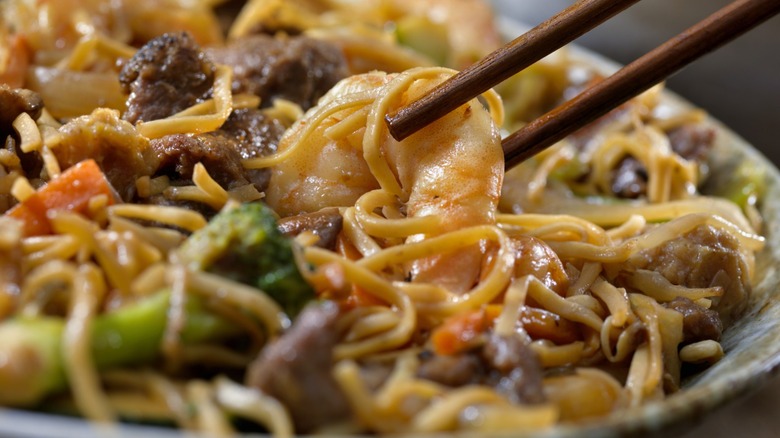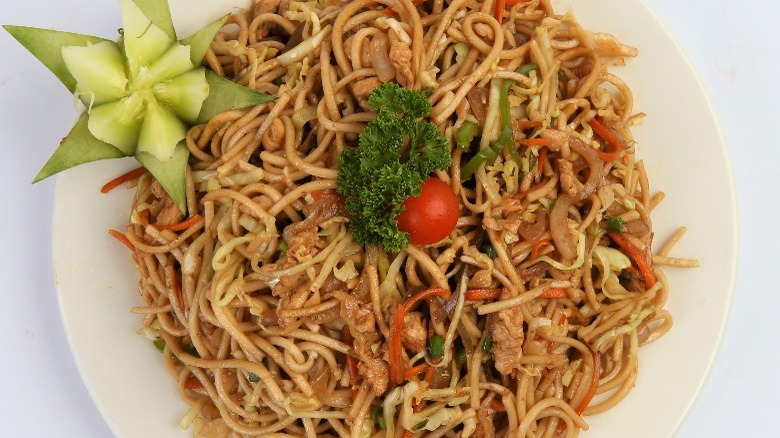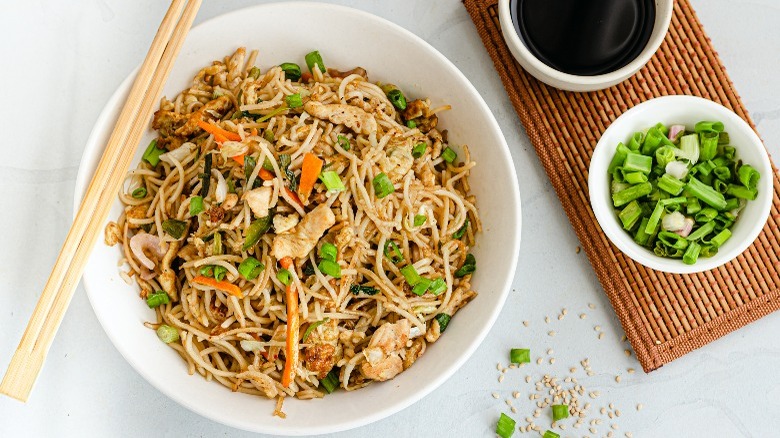What Is Chow Mein, And How Is It Different From Lo Mein?
Chow mein and lo mein are staples of American Chinese restaurant takeout food, but the two distinct types of noodle dishes are often confused with each other. Although similar, the slight divergence in nomenclature is due to differences in preparation. Whereas the noodles, meat, and vegetables are all stir-fried in chow mein, lo mein uses boiled or steamed noodles mixed with a sauce and other ingredients afterward.
This distinction is made all the more confusing by the fact that the East and West Coasts of the United States don't distinguish the two dishes the same way. The lo mein label is mostly the purview of the East Coast; if you order chow mein on the West Coast, expect the softer noodles belonging to what would be classified as lo mein on the East Coast. The fried, crunchy East Coast chow mein is, in fact, "Hong Kong-style chow mein" in the West. This is also why chow mein is often served either "crispy" or "steamed;" the latter designation is more of a lo mein, but chow mein is a more widely used moniker. This is why it's probably best if you're traveling around to ask if the chow mein is being served crunchy or not.
The history and global spread of chow mein
The specific origins of chow mein are unclear, though we do know that it came to the United States through Cantonese immigrants from Guangzhou province in southern China sometime during the mid-nineteenth century Gold Rush. Although both chow mein and lo mein are prime examples of the unique Chinese-American style food that cropped up around the country after this migration wave, the dishes do have Cantonese equivalents, even if they're significantly different than their American counterparts.
The general basis of chow mein as stir-fried noodles means that the basic recipe has a multitude of variations. In the United States alone, it's not uncommon for each Chinese restaurant to have different styles and ingredients in its chow mein recipes. The South likes to serve chow mein with Southern-style toppings like sausage or shrimp gravy, while the town of Fall River, Massachusetts is home to an almost long-forgotten variant of the dish: the chow mein sandwich.
Hakka-style chow mein, referring to a Han Chinese subgroup that's distinct from the Cantonese-speaking originators of American chow mein, is a mainstay of Chinese restaurants in India. The Caribbean, especially Guyana and Trinidad, are fond of making chow mein with local spices and vegetables. Canada distinguishes between "chow mein," "Cantonese-style chow mein," and "Japanese chow mein," the latter served with pickled ginger and dried seaweed on a bun. Least traditional of all, Newfoundland's chow mein nixes the noodles altogether and instead uses strips of cabbage.
How to improvise chow mein
The beauty of chow mein is that you can use any ingredients in your kitchen as long as you stir them up with some noodles. Chinese fillings are obviously more traditional, but the seemingly infinite variations on the dish are proof of the flexibility of chow mein. There's no strict rule about the type of noodles, either, though egg noodles work the best to soak up the sauces. Alternatively, wheat noodles are a good choice since they're essentially the same just without the added egg. Fresh or dried noodles work for the crispy texture of chow mein, whereas fresh noodles are better for creating the softer, slipperier feel of lo mein.
Since chow mein is a stir-fry recipe, you don't have to boil your noodles all the way unless you're looking to make the sort of "steamed" chow mein that's closer to lo mein. All it takes is briefly parboiling the noodles before frying them in a pan cooks them the rest of the way. As a bonus, stir-frying the partially boiled noodles will help to create a crispier coat. Alternatively, you can fry the noodles separately from the mix-ins, creating a sort of "noodle pancake" that acts as a base to pour sauce, meat, and veggies over. The loose definition of chow mein encourages experimentation in the kitchen, so feel free to noodle around with your noodles.



